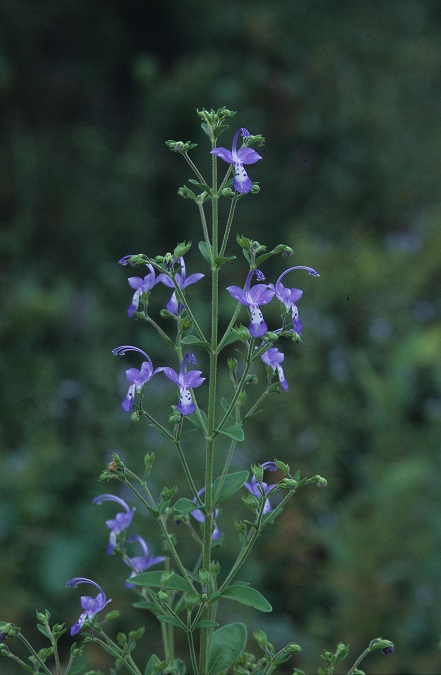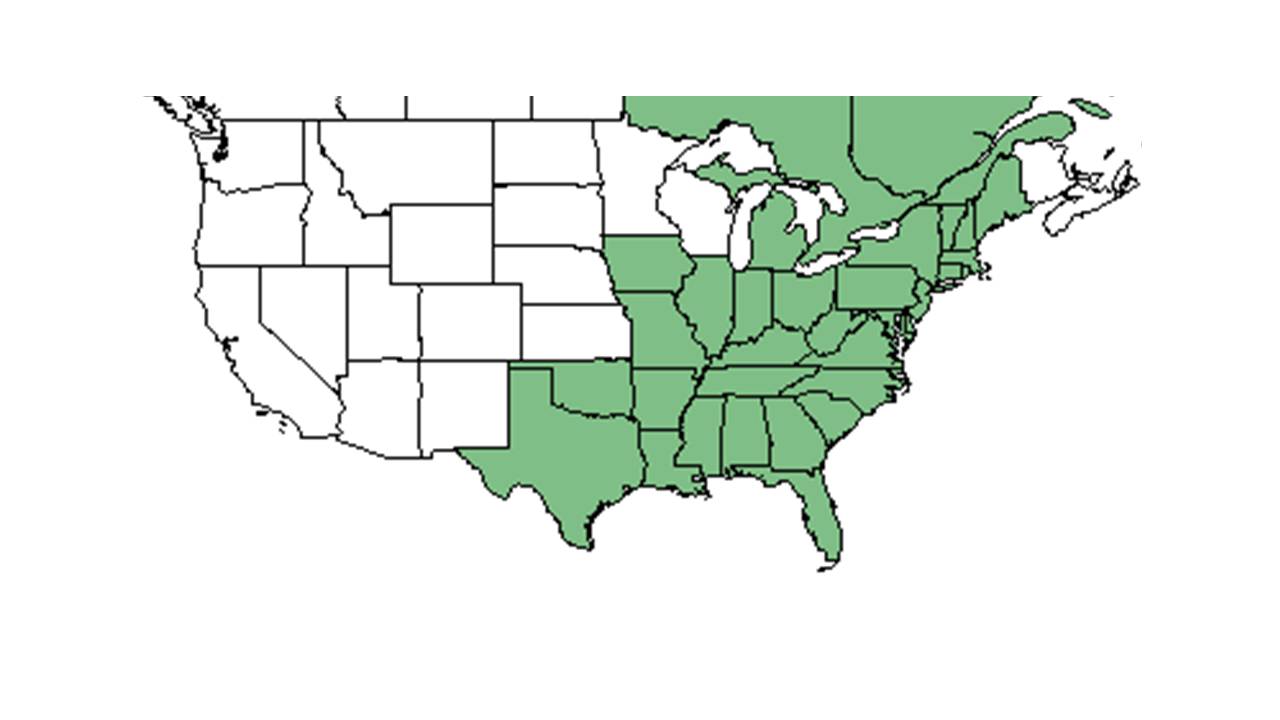Trichostema dichotomum
| Trichostema dichotomum | |
|---|---|

| |
| Photo taken by Gil Nelson | |
| Scientific classification | |
| Kingdom: | Plantae |
| Division: | Magnoliophyta – Flowering plants |
| Class: | Magnoliopsida – Dicotyledons |
| Order: | Lamiales |
| Family: | Lamiaceae ⁄ Labiatae |
| Genus: | Trichostema |
| Species: | T. dichotomum |
| Binomial name | |
| Trichostema dichotomum L. | |

| |
| Natural range of Trichostema dichotomum from USDA NRCS Plants Database. | |
Common names: Forked bluecurls, Common blue curls
Contents
Taxonomic notes
Synonyms: Trichostema dichotomum var. puberulum Fernald & Griscom.[1]
Description
"Pubescent annual or weak perennial herbs from tap roots, freely branched with opposite branches. Stems obscurely angled, usually stipitate-glandular, leafy. Leaves entire or toothed, rarely lobed, petiolate to essentially sessile. Inflorescence a panicle of paired, bracteate, helicoid cymes with a flower at the axis of each pair; bracts similar to the leaves, smaller. Calyx bilabiate, lower lip longer than the upper with 3 essentially equal teeth, upper with 2 similar teeth; corolla blue to violet, zygomorphic, 5-lobed, lowest lobe lip-like, 5-10 mm long, lateral triangular-ovate, 2-4 mm long, tube short. Stamens 4, ca. 2X as long as the corolla, curved between the lateral lobes and curled downward almost meeting the lip; stigma bilobed, style curled in same fashion as stamens. Mericarps brownish to olive or blackish, dull, obovoid."[2]
"At least the principal stems spreading pubescent, the trichomes 0.2-1 mm long, usually bearded at the nodes. Leaves elliptic to elliptic-lanceolate, 2-7 cm long, 0.4-2.3 cm wide, entire, crenate, or rarely loved, base tapered to cuneate or attenuate; petioles 0-1.5 cm long. Mericarps distinctly reticulate, 1.9-2.3 mm long."[2]
Distribution
Trichostema sp. nov. aff. dichotomum is endemic to an area from southeastern North Carolina to northeastern South Carolina.[3]
Ecology
Habitat
In the Coastal Plain in Florida and Georgia, T. dichotomum has been found in burned upland pinewoods; longleaf pine forests; annually burned pine savannas; loamy sand of woodlands; loamy sand of open pine-hickory woods; floodplain forests; sandy loam along bluffs; amidst cypress knees on the shores of lakes and ponds; sandy ridges; burned pond pine shrub bog flatwoods; longleaf pine-turkey oak sand ridges; and at the edges of an open limestone glade.[4] It has been recorded in disturbed habitats such as roadsides; deciduous flatwoods clearings; and a mowed meadow.[4]
T. dichotomum increased its occurrence in response to agriculture in southwest Georgia pinelands. It has shown regrowth in reestablished pinelands that were disturbed by agricultural practices.[5]
Associated species include Vaccinium stamineum, Trichostema setaceum, Scoparia, Panicum, Andropogon gerardii, Angelica dentata, and Helianthus radula.[4]
Phenology
T. dichotomum has been observed flowering in July, September, and October, and fruiting September through December.[4][6]
Seed dispersal
This species is thought to be dispersed by gravity.[7]
Seed bank and germination
Habitats associated with high light levels and large diurnal temperature fluctuations near tortoise mounds are probably favorable for the establishment of T. dichotomum.[8]
Fire ecology
Populations of Trichostema dichotomum have been known to persist through repeated annual burns.[9][10][11]
Pollination
Trichostema dichotomum has been observed at the Archbold Biological Station to host pollinators such as Lasioglossum placidensis (family Halictidae).[12]
Herbivory and toxicology
It was found to be one of the most common spring recruits near recently abandoned tortoise mounds.[13] Bee species such as Caupolicana electa and Dialictus placidensis, have been observed on T. dichotomum.[14][15]
Conservation, cultivation, and restoration
Cultural use
Photo Gallery
References and notes
- ↑ Weakley, A.S. 2015. Flora of the southern and mid-atlantic states. Working Draf of 21 May 2015. University of North Carolina at Chapel Hill, Chapel Hill, North Carolina.
- ↑ 2.0 2.1 Radford, Albert E., Harry E. Ahles, and C. Ritchie Bell. Manual of the Vascular Flora of the Carolinas. 1964, 1968. The University of North Carolina Press. 897. Print.
- ↑ Sorrie, B. A. and A. S. Weakley 2001. Coastal Plain valcular plant endemics: Phytogeographic patterns. Castanea 66: 50-82.
- ↑ 4.0 4.1 4.2 4.3 Florida State University Robert K. Godfrey Herbarium database. URL: http://herbarium.bio.fsu.edu. Last accessed: July 2015. Collectors: Loran C. Anderson, Robert K. Godfrey, R. Komarek, R. A. Norris, Andre F. Clewell, K. Craddock Burks, David Dixon, O. Lakela, R. Kral, James P. Gillespie, R. L. Lazor, A. H. Curtiss, Roy Jervis, John B. Nelson, R. E. Perdue, Jr., Richard S. Mitchell, Bian Tan, Nancy E. Jordan, Ann F. Johnson, Wilson Baker, Cecil R Slaughter, Marc Minno. States and Counties: Florida: Baker, Calhoun, Citrus, Columbia, Duval, Franklin, Gadsden, Gulf, Jackson, Jefferson, Lafayette, Leon, Liberty, Madison, Okaloosa, Wakulla, Walton. Georgia: Grady, Thomas. Compiled by Tall Timbers Research Station and Land Conservancy.
- ↑ Ostertag, T. E. and K. M. Robertson. 2007. A comparison of native versus old-field vegetation in upland pinelands managed with frequent fire, South Georgia, USA. Tall Timbers Fire Ecology Conference Proceedings 23: 109-120.
- ↑ Nelson, G. PanFlora: Plant data for the eastern United States with emphasis on the Southeastern Coastal Plains, Florida, and the Florida Panhandle. www.gilnelson.com/PanFlora/ Accessed: 14 DEC 2016
- ↑ Kirkman, L. Katherine. Unpublished database of seed dispersal mode of plants found in Coastal Plain longleaf pine-grasslands of the Jones Ecological Research Center, Georgia.
- ↑ Bazzaz, F. A. 1979. The physiological ecology of plant succession. Annu. Rev. Ecol. Syst., 10:351- 371.
- ↑ Robertson, K.M. Unpublished data collected from Pebble Hill Fire Plots, Pebble Hill Plantation, Thomasville, Georgia.
- ↑ Glitzenstein, J. S., D. R. Streng, R. E. Masters, K. M. Robertson and S. M. Hermann 2012. Fire-frequency effects on vegetation in north Florida pinelands: Another look at the long-term Stoddard Fire Research Plots at Tall Timbers Research Station. Forest Ecology and Management 264: 197-209.
- ↑ Platt, W.J., R. Carter, G. Nelson, W. Baker, S. Hermann, J. Kane, L. Anderson, M. Smith, K. Robertson. 2021. Unpublished species list of Wade Tract old-growth longleaf pine savanna, Thomasville, Georgia.
- ↑ Deyrup, M.A. and N.D. 2015. Database of observations of Hymenoptera visitations to flowers of plants on Archbold Biological Station, Florida, USA.
- ↑ Kaczor, S. A. and D. C. Hartnett (1990). "Gopher tortoise (gopherus polyphemus) effects on soils and vegetation in a Florida sandhill." American Midland Naturalist 123: 100-111.
- ↑ Deyrup, M. and L. Deyrup (2012). "The diversity of insects visiting flowers of saw palmetto (Arecaceae)." Florida Entomologist 95(3): 711-730.
- ↑ Discoverlife.org [1]